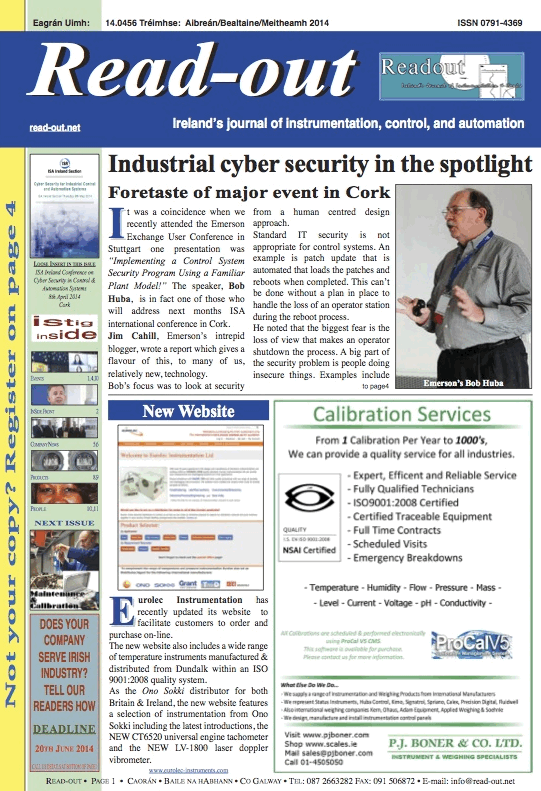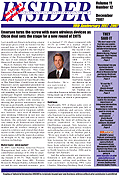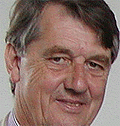

|
|












AWARDS
All contents copyright © 2007 Readout Publications


|
Measurement, Control and Automation Resources throughout the World

Emerson turns the screw with more wireless devices as
Cisco deal sets the stage for a new round of COTS
Last month saw Emerson hosting a major
European press event on wireless for the
second time in 2007, a measure of its
determination to exploit to the full what it
perceives as the advantage over arch rival
Honeywell created by last September's
release of the WirelessHART protocol in
the face of last minute objections from
Honeywell president Jack Bolick.
Despite these real or imaginary subtleties, however, once we'd all thawed out
after drinking Gluehwein in not just one
but two separate and sub-zero al fresco
locations, the principal message wasn't
very subtle at all. Emerson now claims to
dominate the global process automation
market and its wireless strategy is de-
signed to reinforce and extend that domination as the industry goes through what
it anticipates will be the major discontinuity brought on by the rapid adoption of wireless technology.
Market leader - which market?
Field focus
And the achievements are impressive.
Emerson is now able to point to real
installations, solving real problems for
real customers including PPG Lake
Charles, Wheeling Pittsburg Steel, Croda and Milford Power. In Europe, there
have already been a total of nine applications since product was released in
June of this year including on Statoil's
Grane platform in the North Sea and at
BP's Wytch Farm, the largest on shore
oil field in the UK. And its able to quote
and name users reporting that "Five
minutes after installing it, the wireless
network came to life;" "Overall we have
. . . improved throughput by 5%;" and
wireless devices "typically take around
two hours to install compared with up to
two days for a conventional wired unit."
Wheeled out as the tame real life user
was Anders Royroy, project manager for
R&D projects with StatoilHydro which
has installed a total of 22 wireless transmitters on its Grane platform in the
North Sea as part of its long term Mesa
Verde project to develop an entirely
unmanned process platform by 2015.
Perhaps not quite as tame as had been
intended, Royroy conceded that there
had been minor problems with the in-
stallation, not least because Emerson
had been unable to supply a qualified
remote antenna for the gateway for installation in the offshore environment.
Nevertheless installation had been faster
than expected, with all transmitters live
in a matter of minutes. Interestingly,
and another feather in the Emerson cap,
the wireless networks integrate not with
an Emerson but with an ABB DCS.
Control and safety
Does it or doesn't it?
Meanwhile how confident is the Emerson team that it has indeed backed the right horse at the device
level and that WirelessHART will not be stranded outside the eventual ISA 100 standard? Chief
strategic officer Peter Zornio says that "We are pretty confident and comfortable that
WirelessHART is a protected path within SP 100." All of which, rather strangely was meant to be
the preliminary to the main event, the announcement of the extension to Europe of the agreement,
first announced in the US in September, between Emerson and Cisco to deliver wireless plant networks
and applications based on Cisco's Unified Wireless Architecture (INSIDER, October 2007, page 2).
Just who gets the best out of this deal
is by no means clear. Emerson certainly
gets the opportunity to thumb its collective nose at Honeywell by presenting an
architecture so similar to the latter's
OneWireless above the device level as to be
barely indistinguishable. Moreover what
purists might argue it lacks in logical
consistency and elegance, it looks like
more than making up for in having the
backing of one of the best known brands
in enterprise communications.
IT savvy
But the advantage for Emerson seems
to go further than that. Not only does the
Cisco architecture support the full gamut
of video, voice, mobility and tracking applications but Emerson will be able to
leverage Cisco's extensive partner network and hence allow its customers to
choose their preferred partner for specific
applications. Moreover, while Emerson
continues to insist that users will not in
general need help in deploying field device
networks, they will, it concedes need support if they're ambitions go further up into
the plant hierarchy. Emerson is building
up a global network of service and technical support resources and will design,
specify, install and support both field
networks and wireless plant networks but
it will also be able, as Zornio puts it, to
"lean on Cisco's expertise."
It's also clear that Cisco's ambitions
don't end with Emerson - or indeed
Rockwell. "Cisco doesn't do any exclusive
deals," said Robinson, although he added
that " ... in terms of building a global
market strategy this is the only one that
we are working on right now and it doesn't make any sense to introduce any new
ones until we have established that we
can actually do something together."
So despite is non exclusivity, the deal
with Cisco allows Emerson to counter
suggestions that its solution addresses
only one part of the total plant wireless
application space. At the same time it
enables it to differentiate that overall offering by allowing the user initially to
address only that part which offers the
best immediate ROI, be that at the device
or the plant level. As Zornio put it, "You
can do what you want and you don't have
to do the whole thing."
All of which sounds entirely plausible.
So why did one gain the impression that
there was more to this than met the eye?
More than a decade ago, Emerson was in
the forefront of the revolution which saw
DCS vendors abandoning proprietary technology and embracing COTS (Commercial
Off The Shelf) technology in the form of
Microsoft and Dell. Robinson's second
slide carried the caption "The Network as
a Platform." Could it be that a decade form
now the process automation industry will
be looking back at the Cisco-Emerson
deal as the point when the network
emerged as THE platform?
Emerson has been in the condition
monitoring business ever since it acquired
Knoxville, Tennessee based Computational
Systems, Inc (CSI). Now with the launch of
the CSI 6000 it is extending its capability,
and its PlantWeb architecture to include
industry best practice API 670 protection
of turbomachinery which, says David
Dunbar, "is a really big deal for us."
Moreover, because it integrates directly
with Emerson's DeltaV and Ovation DCSs
and with its AMS Suite asset management
system, Marshall is able to claim that
Emerson is "the only company that offers
integration direct to process control."
As well as monitoring both relative and
absolute vibration, the system can measure case expansion, differential expansion and thrust position and, integrating
with the control system , allows operation
of the asset to be optimized to meet the
users overall performance objectives. With
between 40 and 50% of all equipment
breakdowns believed to be related to poor
operating practice, Emerson argues that
"Vibration integrated with process control
becomes information."
Rather surprisingly, however, the subsequent demonstration showed the new
system integrating with DeltaV but made
no mention of the role of a safety system
such as Emerson's own DeltaV SIS, despite the fact that vendors such as Triconex
and ICS Triplex list turbo machinery protection as one of their major areas of
application.
When we put the question informally to
Emerson executives after the presentation, we didn't seem to get much more
than some rather blank looks.
|
Back to Industrial Automation INSIDER Homepage
The site is mantained by Eoin Ó Riain and any suggestions or thoughts are more than welcome.
Suggestions should be mailed to readout@iol.ie. Other Contact Details
The Signpost has been honoured to receive a number of awards.






